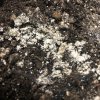Correct. Not much calcium is water soluble, this is especially true when it is in carbonate form. This is why my first thought seeing this chalky substance was Calcium.
OP's tap water wasn't a direct cause of this, but definitely played an indirect role. 200ppm water typically does have both Calcium and Magnesium in it,
but the Calcium used in municipal water that tests <200 ppms is typically not in Carbonate form, and thus will not affect one's pH. In fact, that majority of municipal water sources shouldn't negatively effect pH in terms of alkalinity. Not all Calcium is in carbonate form, capable of causing alkaline pH. Calcium doesn't cause alkaline pH,
carbonate does. That said, Calcium is still Calcium.
It is well water sources that are typically problematic. Huge difference between water that is "hard" coming from a municipal water district, compared to water that is "hard" coming from an underground well source. The water districts typically add and/or subtract things to the water to get it to a specific PPM, whereas well water does not have a water district adding and subtracting things from the well water. What you get is what you get, and with "hard" well water, problems are typically the result of calcium carbonate in the water, or excess iron in some cases. Depends on where the water is coming from.
Looks like this is in fact a Calcium issue, but it isn't that much of an "issue". I've seen
@myke tomato plant photos before, they look very text book in terms of overall health and the like. The bottom leaves do in fact show
slight Mg deficiencies, however the overall health of the plant is great, so I'm inclined to believe that there isn't much of an issue overall. However, it could manifest itself as an issue at any moment, and IMO this is the perfect time to take action and remedy the situation.
Having read some of OPs responses, I'm thinking that the residue is mostly the gypsum from the Gaia Green top dresses, and not the OSF. While this is technically an "imbalance" so to speak, it isn't likely to cause issues if it is in fact just the Gypsum.
Since OPs uses different water outdoors, water has Calcium in it already, he can still use Gaia Green indoors and be just fine. That residue is certainly Calcium, but likely in the form of Gypsum which is a sulfate and not a carbonate and should not negatively affect the soil too much in terms of pH, but there is definitely a risk of excess Ca locking out K/Mg. OP can keep using Gaia Green indoors, so long as the water is RO/Distilled, which I'd guess he's doing if his indoor SIPs don't have this residue.
Simply finding organic blends devoid of Calcium, and continuing to use his tap water from the hose, will quickly remedy the problem. Hell, its not even that much of a problem for now. However, given enough time in a no-till environment,
excess is still excess.
OP needs to be mindful of the fact that his outdoor water source has Calcium in it, and remove Calcium inputs from his top dresses in the future. While OP likely won't experience issues related to excessive alkalinity from carbonate sources in water/dirt, this will become a Calcium toxicity at some point in time. If OP continues to use Gaia in the outdoor SIPs, the water needs to be RO/distilled like it is indoors.
However, the simpler approach would be to top dress with amendments devoid of Calcium, and allow the water to be the source for Calcium.
With organics/living soil, there is greater success to be had by working with what you have as opposed to against it.
Like my limestone well water for instance. I could try to pH down the water and murder my soil with sulfur, but that's way too time consuming and costly. Rather than work
against my water, I work
with it. I simply removed all Ca inputs from my soil, and stopped liming my soil, as my water not only limes my soil but also provides sufficient Ca to the soil as well.









